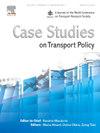Automated statewide estimation of crash-induced delay and queueing using crowdsourced data
IF 3.3
Q3 TRANSPORTATION
引用次数: 0
Abstract
Due to the unpredictable nature of crashes, accurately predicting when crashes will happen is challenging. Therefore, a key strategy for enhancing safety focuses on mitigating the impact of crashes when they do occur. Many agencies have adopted this approach by implementing incident management programs designed to reduce congestion and prevent secondary crashes. These programs require quick and efficient responses, which depend on timely and relevant information, such as accurate estimates of crash-induced congestion. This study introduces a method for estimating crash-induced delay and traffic congestion queue length, using machine learning and fusing multiple data sources. Police-reported crash data and Waze crowdsourced data were collected for all thruways in New York State. A hybrid model combining XGBoost, autoencoders, and gated residual networks was trained using the spatiotemporal alignment of multiple data sources. This model enables statewide estimations across different crash types and severity levels, accounting for roadway, surface, and weather conditions. The proposed model achieved an average error of 0.628 min for estimating crash-induced delays and 0.768 miles for queue length estimation. Its performance was evaluated against six state-of-the-art benchmark models, and the results demonstrated that our model consistently outperformed all others in both delay and queue length predictions. These findings have practical implications for roadway planning and traffic management, particularly in enhancing driver navigation by providing accurate crash-related information through variable message signs. This information could help drivers make informed route choices, including potential detours, while also providing valuable data to roadway agencies to prevent secondary crashes.
使用众包数据对崩溃引起的延迟和排队进行自动全州估计
由于崩溃的不可预测性,准确预测崩溃何时发生是一项挑战。因此,提高安全性的一个关键策略是在发生碰撞时减轻其影响。许多机构通过实施旨在减少拥塞和防止二次崩溃的事件管理程序采用了这种方法。这些项目需要快速有效的响应,这取决于及时和相关的信息,比如对交通事故引起的拥堵的准确估计。本研究介绍了一种使用机器学习和融合多个数据源来估计碰撞引起的延迟和交通拥堵队列长度的方法。警方报告的撞车数据和Waze众包数据收集了纽约州所有高速公路的数据。结合XGBoost、自动编码器和门控残差网络的混合模型使用多个数据源的时空对齐进行训练。该模型可以在全州范围内对不同的碰撞类型和严重程度进行估计,并考虑到道路、路面和天气条件。所提出的模型在估计碰撞引起的延误时的平均误差为0.628分钟,在估计队列长度时的平均误差为0.768英里。它的性能根据六个最先进的基准模型进行了评估,结果表明,我们的模型在延迟和队列长度预测方面始终优于所有其他模型。这些发现对道路规划和交通管理具有实际意义,特别是通过可变信息标志提供准确的碰撞相关信息来增强驾驶员导航。这些信息可以帮助司机做出明智的路线选择,包括潜在的绕路,同时也为道路管理机构提供有价值的数据,以防止二次碰撞。
本文章由计算机程序翻译,如有差异,请以英文原文为准。
求助全文
约1分钟内获得全文
求助全文

 求助内容:
求助内容: 应助结果提醒方式:
应助结果提醒方式:


